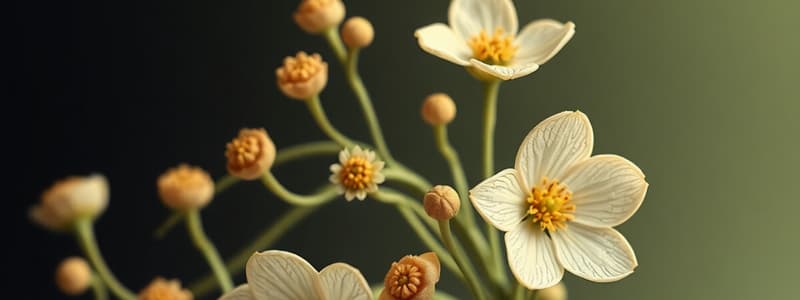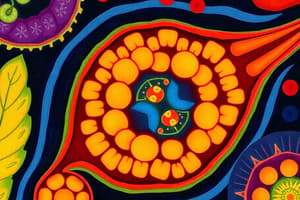Podcast
Questions and Answers
What is the primary function of collenchyma cells in the stem?
What is the primary function of collenchyma cells in the stem?
- Transport of nutrients
- Water storage
- Photosynthesis
- Mechanical strength and flexibility (correct)
Which characteristic distinguishes sclerenchyma cells from collenchyma cells?
Which characteristic distinguishes sclerenchyma cells from collenchyma cells?
- More flexible than collenchyma
- Alive at maturity
- Presence of lignin (correct)
- Cell walls are not thickened
What distinguishes angular collenchyma from annular collenchyma?
What distinguishes angular collenchyma from annular collenchyma?
- Shape of the cells (correct)
- The thickness of cell walls
- Their location within the plant
- The composition of cell wall materials
What is the primary function of parenchyma cells in the stem?
What is the primary function of parenchyma cells in the stem?
What type of plant tissue is characterized by its role in storage and is often found in younger stems?
What type of plant tissue is characterized by its role in storage and is often found in younger stems?
Which of the following is NOT a characteristic of collenchyma cells?
Which of the following is NOT a characteristic of collenchyma cells?
Which characteristic is NOT associated with parenchyma cells?
Which characteristic is NOT associated with parenchyma cells?
What is the main reason why sclerenchyma cells do not facilitate gas exchange?
What is the main reason why sclerenchyma cells do not facilitate gas exchange?
How do parenchyma cells assist in leaves aside from storing substances?
How do parenchyma cells assist in leaves aside from storing substances?
Where are collenchyma cells typically located in a plant structure?
Where are collenchyma cells typically located in a plant structure?
What distinguishes parenchyma cells from sclerenchyma cells?
What distinguishes parenchyma cells from sclerenchyma cells?
Which of the following cell types is known for having cell walls that are not lignified?
Which of the following cell types is known for having cell walls that are not lignified?
In which type of tissue would you primarily find parenchyma cells?
In which type of tissue would you primarily find parenchyma cells?
What role do intercellular spaces in parenchyma cells serve?
What role do intercellular spaces in parenchyma cells serve?
Which of the following best describes the composition of parenchyma cells?
Which of the following best describes the composition of parenchyma cells?
What type of environmental condition is parenchyma cells particularly important for in plants?
What type of environmental condition is parenchyma cells particularly important for in plants?
What is a primary function of parenchyma cells in leaves?
What is a primary function of parenchyma cells in leaves?
How are parenchyma cells characterized in terms of their structure?
How are parenchyma cells characterized in terms of their structure?
In which part of the leaf are parenchyma cells primarily located?
In which part of the leaf are parenchyma cells primarily located?
Which statement about parenchyma cells is false?
Which statement about parenchyma cells is false?
What role do parenchyma cells play in gas exchange within the leaf?
What role do parenchyma cells play in gas exchange within the leaf?
Which type of parenchyma cell is primarily responsible for photosynthesis?
Which type of parenchyma cell is primarily responsible for photosynthesis?
What distinguishes parenchyma cells from sclerenchyma cells?
What distinguishes parenchyma cells from sclerenchyma cells?
Which of the following best describes the role of parenchyma cells in storage?
Which of the following best describes the role of parenchyma cells in storage?
Flashcards
Leaf Trichomes
Leaf Trichomes
Extensions of epidermal cells that form hairs on leaves and stems with various functions.
Trichome Function Variation
Trichome Function Variation
Trichomes have different functions, such as protection from herbivores, prevention of water loss, and protection from UV light
Root Hairs
Root Hairs
Tubular extensions of epidermal cells that greatly increase a root's surface area for water absorption.
Root Epidermis
Root Epidermis
Signup and view all the flashcards
Parenchyma Cells
Parenchyma Cells
Signup and view all the flashcards
Collenchyma Cells
Collenchyma Cells
Signup and view all the flashcards
Sclerenchyma Cells
Sclerenchyma Cells
Signup and view all the flashcards
Collenchyma cells
Collenchyma cells
Signup and view all the flashcards
Angular Collenchyma
Angular Collenchyma
Signup and view all the flashcards
Annular Collenchyma
Annular Collenchyma
Signup and view all the flashcards
Parenchyma cells
Parenchyma cells
Signup and view all the flashcards
Sclerenchyma cells
Sclerenchyma cells
Signup and view all the flashcards
Lignin
Lignin
Signup and view all the flashcards
Vascular tissue
Vascular tissue
Signup and view all the flashcards
Xylem
Xylem
Signup and view all the flashcards
Phloem
Phloem
Signup and view all the flashcards
Dicot root
Dicot root
Signup and view all the flashcards
Angiosperm Tissues
Angiosperm Tissues
Signup and view all the flashcards
Leaf Epidermis
Leaf Epidermis
Signup and view all the flashcards
Trichomes
Trichomes
Signup and view all the flashcards
Root Hairs
Root Hairs
Signup and view all the flashcards
Parenchyma Cells
Parenchyma Cells
Signup and view all the flashcards
Collenchyma Cells
Collenchyma Cells
Signup and view all the flashcards
Sclerenchyma Cells
Sclerenchyma Cells
Signup and view all the flashcards
Vascular Tissues
Vascular Tissues
Signup and view all the flashcards
Xylem
Xylem
Signup and view all the flashcards
Phloem
Phloem
Signup and view all the flashcards
Meristematic Tissues
Meristematic Tissues
Signup and view all the flashcards
Study Notes
Angiosperm Tissues - Practical 2
- Plants have three types of organs: leaves, stems, and roots.
- Each organ is composed of tissues.
- A tissue is a group of cells with a common structure and function.
Epidermis
- Trichomes are hairs on the epidermis.
- Root hairs are tubular extensions of epidermal cells.
Ground Tissues
- Parenchyma cells are thin-walled and alive at maturity.
- Collenchyma cells are thick-walled and alive at maturity.
- Sclerenchyma cells are thick-walled and dead at maturity.
Vascular Tissues
- Xylem transports water.
- Phloem transports food products.
Meristematic Tissues
- Apical meristems are at the tips of roots and shoots.
- Lateral meristems are in the stems and roots.
Leaf Epidermis (Ficus Leaf)
- Ficus has two layers of epidermal cells.
- Epidermal cells provide support to the leaf, holding the leaf's shape to collect light.
- Epidermal cells secrete a waxy cuticle that provides a waterproof layer, vital in arid regions.
Leaf and Stem Trichomes
- Trichomes are extensions of epidermal cells that form hairs.
- Trichomes come in various types with different functions.
- Examples: Aerva, Forsskaolea, Poppy (Papaver or Lewisia stems), Stachys, Teucrium.
Poppy (Papaver) or Lewisia Stems
- These stems have a dense layer of long stiff hairs.
- These hairs protect against insect herbivores, as insects cannot push through them.
Teucrium
- Teucrium is an example of a high-altitude plant.
- Exposed to strong UV light, dehydrating winds and cold winter nights.
- Its stems and leaves have white UV-reflecting hairs that protect from wind, cold, and UV light.
Aerva
- Aerva lives in extreme arid conditions.
- Its stems and leaves have small umbrella-shaped trichomes that shade the plant from the sun.
Stachys
- Stachys is a native plant of Turkey.
- Its hairy leaves are an adaptation to reduce water loss and trap surface humidity.
Root Epidermis and Root Hairs
- Roots have a thin cuticle allowing easy water entrance.
- Most water is absorbed through root hairs.
- Root hairs are tubular extensions of epidermal cells, increasing the root's surface area for absorption.
Ground Tissues (Parenchyma, Collenchyma, and Sclerenchyma)
- Parenchyma cells are living cells with cell walls, storing water and food.
- In leaves, parenchyma cells conduct photosynthesis.
- Collenchyma cells have thickened cell walls at the corners, providing mechanical strength.
- Sclerenchyma cells are dead cells with thick walls, offering rigid support.
Vascular Tissues (Xylem and Phloem)
- Xylem transports water in a X pattern in the centre of the root.
- Phloem transports food in small polygonal cells between the xylem arms.
Meristems (Onion root tip)
- The root tip has different regions:
- Root cap: protects the apical meristem.
- Apical meristem: cells with rapid mitotic divisions (tiny cells).
- Elongation zone: cells enlarge, pushing the root down.
- Maturation zone: cells start functioning.
Tasks (General)
- Specific tasks for observing and drawing various plant tissues (leaf epidermis, trichomes, root epidermis, root hairs, ground tissues, vascular tissues, and meristem) are provided. Page numbers for location of the relevant material are provided in the slides.
Studying That Suits You
Use AI to generate personalized quizzes and flashcards to suit your learning preferences.




